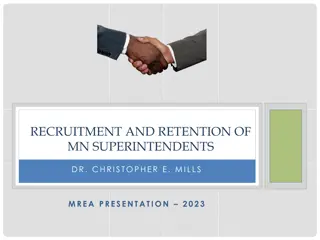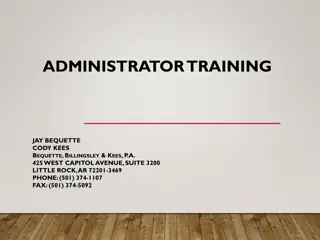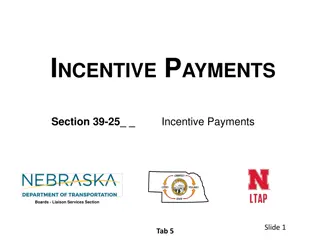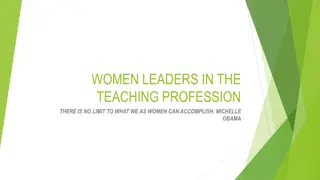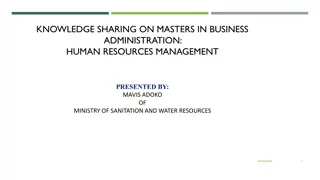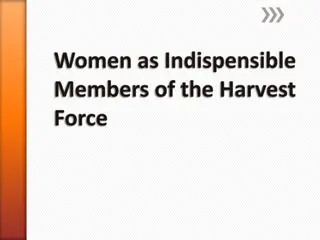Challenges Faced by Female Superintendents in Leadership Roles
Female superintendents encounter challenges such as being perceived as too aggressive, not well-liked by peers, and facing stereotypes that hinder their success. Despite a steady increase in female superintendents, there is still a long way to go for proportional representation in educational leadership roles. The study highlights the disparity in likability between male and female professionals and the struggles faced by women in leadership positions.
- Female superintendents
- Leadership challenges
- Gender stereotypes
- Educational equity
- Professional barriers
Uploaded on Oct 07, 2024 | 0 Views
Download Presentation

Please find below an Image/Link to download the presentation.
The content on the website is provided AS IS for your information and personal use only. It may not be sold, licensed, or shared on other websites without obtaining consent from the author. Download presentation by click this link. If you encounter any issues during the download, it is possible that the publisher has removed the file from their server.
E N D
Presentation Transcript
Women In Leadership MASA Conference ~ Grand Traverse Resort ~ September 20, 2016 Susan Wakefield, Wakefield Consulting, LLC Sara Shriver, SLS Consulting, LLC
History of Female Superintendents 1909 Ella Young Chicago First Female Superintendent Percentage of Women Superintendents Nationwide 30 25 23 21.7 13.2 6.7 3 1930 1970 1993 2000 2007 2012 2016
History of Female Superintendents In 2012, 23% of superintendents were women, while 76% of teachers and 52% of principals were women Although there has been a steady increase in female superintendents, the average increase annually is only .07%. At this rate, it will take 77 years before female superintendents are represented proportionally.
LEAN IN Sheryl Sandberg 2014 Chapter 3 Success and Likeability 2003 Heidi/Howard Study (Columbia Business & New York University) Real life entrepreneur, successful venture capitalist Outgoing personality, vast personal and professional network Two groups both respected, but Howard came across as the more appealing colleague Heidi was described as being selfish, not the type of person you would want to hire or work for
LEAN IN Continued We characterize men and women in opposition to each other Professional achievement and all the associated traits get assigned to the men column Heidi focused on her career, amassed power and therefore, violated our stereotypical expectations for women Howard did the exact same thing and therefore, lived up to the expectations we have for men End result We like Howard and we dislike Heidi.
Stereotypes Men Providers, decisive, driven Women Caregivers, sensitive, communal
Female Superintendents Women who do this work are often recognized for their success but are: not as well liked by their peers. viewed as too aggressive. perceived as not a team player. seen as a bit too political. seemingly non-trustworthy. referred to as difficult.
LEAN IN Continued The world wants us to be less like Heidi and more like Howard. So if we are driven and focused on results, rather than pleasing others, we are acting like a man and people will dislike us. So we find ourselves down-playing our achievements, expressing self- doubt, apologizing; all so we are likable.
Where are all the Women Superintendents? Thomas E Glass American Association of School Administrators Of our nation s 13,728 superintendents, 1,984 today are women. Yet 72 percent of all K-12 educators in this country are women, according to the U.S. Department of Education.
"2000 Study of the American School Superintendency." A study by Thomas E Glass In AASA s latest 10-year examination of the profession, women accounted for 297 of the 2,262 superintendents who responded to the 90-item survey. The analysis of this data lends insights on the lack of better representation of women in the superintendency.
#1 Poorly Positioned Women are not in positions that normally lead to the superintendency. Most superintendents come from the secondary level and most females are elementary teachers. Secondary teachers have more experiences that can move them into administration and the first step toward the superintendency
#2 Lack of Credentials Women are not gaining superintendent s credentials in preparation programs. Only 10 percent of women in doctoral programs are opting to earn the superintendency credential along with their educational specialist or doctoral degree.
#3 Lack of Credentials Women are not as experienced nor as interested in districtwide fiscal management as men. Very few of the women in the study had personnel or fiscal responsibilities. One third of the women in the study said the Board hired them to be an instructional leader.
#4 Personal Preferences Women are not interested in the superintendency for personal reasons. Women administrators spend more time in the classroom than men before making the shift to administration. Typically women like a better balance of home and work; superintendents spend 50+ hours away from home a week.
#5 Glass Ceiling School boards are reluctant to hire women superintendents. 82 percent of women superintendents in the AASA study indicated school board members do not see them as strong managers 76 percent felt school boards did not view them as capable of handling district finances. 61 percent felt that a glass ceiling existed in school management, which lessened their chances of being selected.
#6 Glass Ceiling Women enter the field of education for different purposes. Women today who choose to enter education as a career may want to be teachers, not administrators; hence so few women superintendents.
#7 Glass Ceiling Women enter too late. Women take several years for child-rearing. Men start their move into administration at about age 27. Women start at age 30 or later. Women move into the superintendent positions at about age 50, and with retirement just a few years away choose not to pursue a career change.
Four Strategies to Pursue for Women in Leadership Strategy 1: Change the nature of the superintendency. More time and funds for central office administrators to share the work load and develop mentors for up and coming superintendents.
Four Strategies to Pursue for Women in Leadership Strategy 2: Boards should make it possible for women superintendents to excel in what they like to do. Shift budget and policy to Assistant Superintendents and allow Superintendents to do more of the curriculum and instruction to improve student achievement on high stakes state assessments.
Four Strategies to Pursue for Women in Leadership Strategy 3: States and higher education institutions should provide incentives to women to gain the superintendent s certificate. State-funded yearlong internships would allow leaders to gain and understanding of the positions and mentors may help to influence future superintendents.
Four Strategies to Pursue for Women in Leadership Strategy 4: Districts and search firms should be rewarded by states for hiring women or minority superintendents. Financial incentives might be given by states to schools districts that hire women or minority superintendents. One possibility: a grant equal to the first-year salary.
"2000 Study of the American School Superintendency." A study by Thomas E Glass For more information on the most recent 10 year studies by Thomas E Glass, E-mail: tglass@memphis.edu. http://www.aasa.org/SchoolAdministratorArticle.aspx?id=14 492
Thoughts? Turn and Talk at your table about the research shared. Think of one new learning you had. Think of one question that has been raised? Be ready to share out one idea: either new learning or question raised.
Contact Us Susan Wakefield susan@wakefieldconsultingllc.com Sara Shriver saraleeshriver@gmail.com


